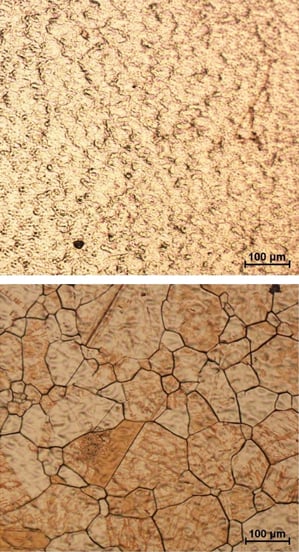Graphene Helps Copper Wires Keep Their Cool
When people in the chip industry talk about the thermal problems in computer processors, they get dramatic. In 2001, Pat Gelsinger, then vice president of Intel, noted that if the temperatures produced by the latest chips kept rising on their current path, they would exceed the heat of a nuclear reactor by 2005, and the surface of the sun by 2015. Fortunately, such thermal disaster was averted by slowing down the switching speeds in microprocessors, and by adopting multicore chip designs in which several processors run in parallel.

Now the semiconductor industry has another thermal problem to sort out. As chip components shrink, the copper wiring that connects them must shrink, too. And as these wires get thinner, they heat up tremendously.
A potential solution to this interconnect fever has been found in the form of graphene, an exotic material made from single-atom-thick sheets of carbon that is a superlative conductor of both electrons and heat.
Materials scientists already use copper as a catalyst to grow graphene for other uses. So Alexander Balandin of the University of California, Riverside, and Kostya Novoselov, a physicist at University of Manchester, U.K., who won the 2010 Nobel Prize in Physics for his foundational work with graphene (see “Graphene Wins Nobel Prize”), decided to leave the graphene on the copper to see how it affected the metal’s thermal properties. In a paper published in the journal Nano Letters, they report that a sandwich made of graphene on both sides of a sheet of copper improves the copper’s ability to dissipate heat by 25 percent—a significant figure for chip designers.
Balandin says that the graphene itself doesn’t seem to conduct the heat away. Rather, it alters the structure of the copper, improving the metal’s conductive properties. Heat moving through copper is usually slowed by the crystalline structure of the metal. Graphene changes this structure, causing those walls to move farther apart, and allowing heat to flow more readily, says Balandin.
Studies were done with relatively thick sheets of copper—much larger than the copper wires found in computer chips—but Balandin expects that the heat-conducting effect will be seen in thinner copper wires, too. He’s now working on copper-graphene wires as small as those used in commercial computer chips.
The problem is an urgent one. This year, Intel is expected to announce products containing 14-nanometer transistors, with copper interconnects about on this scale or even smaller. Copper wires will not work below 10 nanometers, and it’s not clear what will. “We haven’t yet found an interconnect material that can work beyond 10 nanometers,” partly due to overheating, says Saroj Nayak, a physicist at the Center for Integrated Electronics at the Rensselaer Polytechnic Institute in Troy, New York.
Majeed Foad, an electrical engineer at Applied Materials, a semiconductor-equipment maker headquartered in Santa Clara, California, who helps the company track research on new materials, says graphene’s properties are exciting, but adds that as chip components are miniaturized, they become more sensitive to high temperatures. It takes a lot of heat to make good quality graphene—Balandin and Novoselov heated their wires to over 1,000 °C. Foad says such temperatures would degrade transistors and other chip components. Balandin, however, points to lab experiments that demonstrate that graphene can be grown at lower temperatures, at least in the research setting.
Regardless, Foad says, chip makers won’t be in any rush to embrace graphene. “Changing materials is very painful, so we will squeeze every last drop of performance out of what we have,” he says.
It’s clear that simply cramming more transistors into processors and putting more processors in chips is not going to be tenable much longer. High-end chips already contain about 50 to 60 kilometers of copper wiring and multiple cores.
Jonathan Candelaria, director of interconnect research at the Semiconductor Research Corporation, an industry consortium in Durham, North Carolina, says that adding more transistors doesn’t improve performance the way it used to. The solution may again turn out to be adopting fundamentally different architectures. New ways of designing and packaging chips could help solve the heat problem, says Candelaria, and this will give the industry time to work out problems with new materials, perhaps including the new graphene-copper hybrids.
Keep Reading
Most Popular
Large language models can do jaw-dropping things. But nobody knows exactly why.
And that's a problem. Figuring it out is one of the biggest scientific puzzles of our time and a crucial step towards controlling more powerful future models.
How scientists traced a mysterious covid case back to six toilets
When wastewater surveillance turns into a hunt for a single infected individual, the ethics get tricky.
The problem with plug-in hybrids? Their drivers.
Plug-in hybrids are often sold as a transition to EVs, but new data from Europe shows we’re still underestimating the emissions they produce.
Google DeepMind’s new generative model makes Super Mario–like games from scratch
Genie learns how to control games by watching hours and hours of video. It could help train next-gen robots too.
Stay connected
Get the latest updates from
MIT Technology Review
Discover special offers, top stories, upcoming events, and more.